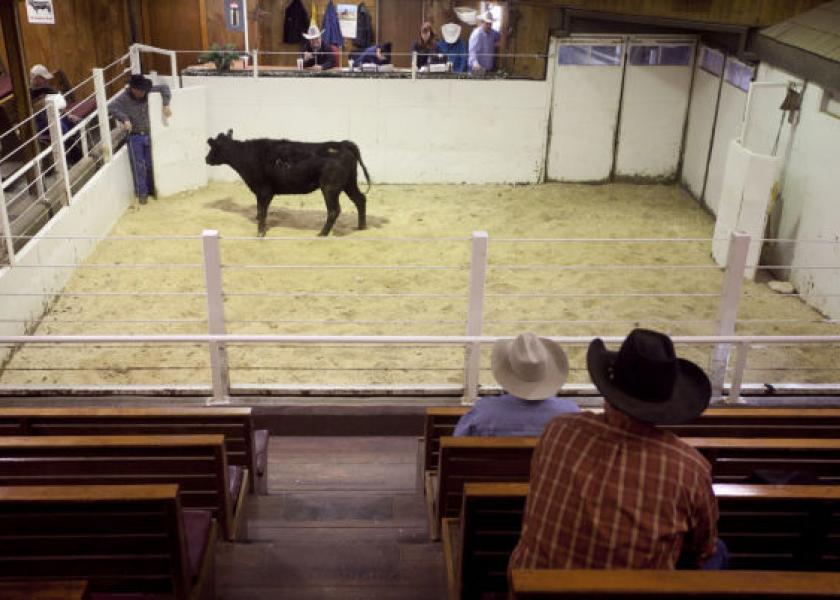High Cattle Prices Push up Beef Cost for Consumers

All it took was a slight nod of the head or a flick of the finger from a potential buyer to send the auctioneer at the St. Onge Livestock Company in South Dakota further into a rat-a-tat chant.
For sale was a nearly 1,200-pound cow that furiously rounded the auction ring, kicking up sawdust and dirt as a bullwhip cracked over its head.
The bidding war was on.
About 15 people sat scattered along the tiered bleachers of the auction ring as the auctioneer breathlessly shouted out bids at a mile-a-minute pace. The price steadily climbed to a rarely seen $1.16 a pound, making the cow and its flesh worth almost $1,400.
"Sold," he called out, abruptly ending the sale as workers chased in the next of nearly 1,500 head of cattle to be sold at the auction last week.
Cattle ranchers have been taking advantage of record cattle prices over the past 14 months, keeping the St. Onge Livestock Company auction busy.
Those record cattle prices have put more money in the pockets of ranchers, but they also helped push up the price of ground beef and steak at grocery stores to record levels.
On Wednesday, Terry Buchholz, 62, of Rapid City, scanned the meat cooler at Wal-Mart where lean ground beef was selling at $5.86 per pound. She turned away when she couldn't find anything within her price range.
In April of 2011, the national average price of ground beef was just $2.95 per pound, according to the USDA.
"It's outrageous, almost $6 a pound for hamburger," Buchholz told the Rapid City Journal. "We've cut back a lot on eating hamburger."
But Buchholz seems to be an anomaly among consumers, as demand for beef hasn't fallen much as prices have risen, said Becky Goosen, owner of Cutting Edge Meat Market in Rapid City.
"It's slowed down a little bit, but not much," Goosen said. "We have our regulars still coming in, and it seems that there are always new people coming in."
Across South Dakota for the week of Dec. 6, steers weighing 500 to 600 pounds sold to feedlots were purchased at the average price of $298.46, according to the USDA. A year ago those same steers were selling for $193.47. The price for young steers is typically far lower than when they are full grown and sold for slaughter.
Cattle are selling at very high rates, nationally and locally, and retail prices have to go up accordingly, said Ken Olson, a South Dakota State University Extension beef specialist.
"A whole bunch of things have converged all at once that nobody expected, to push (prices) higher," Olson said.
The total number of head of cattle across the country is the lowest since the early 1950s, as severe droughts over the past few years forced many ranchers to sell off large portions of their herds, Olson said.
That sudden surplus of beef into the market helped to drive down retail beef prices at the grocery store for consumers in the early 2000s, he said. But now there is a shortage of cattle being slaughtered, and that has helped push up prices.
Olson also said that since prices have bounced back, and the drought has lifted in many parts of the country, ranchers aren't selling as many heifers and cows to slaughter houses. Instead they're trying to rebuild their herds.
"Not only are the total numbers down, but the number of calves we're sending to feedlots on the heifer side are down," Olson said.
As the price to feed cattle has decreased steadily over the last year — as corn and alfalfa prices have fallen — cattle buyers at auction also are driving up prices as they have more money to spend, Olson said.
"Feedlots and slaughterhouses need cattle, and they just keep bidding prices higher and higher every month," Olson said. "They're trying to outbid each other."
But continued demand for beef at the grocery store, despite higher prices, is really helping prices rise to record levels, Olson said.
"We're still recovering from the recession, but people have the spending power to buy beef," Olson said. "People like beef, so when they can afford it, they spend on it."
While high beef prices are cutting into consumers' pocket books, they are helping ranchers like Cheryl Burghduff rebuild herds and help offset exorbitant costs.
"It's been a really positive thing," Burghduff said. "It's helping to catch us up from the bad years."







